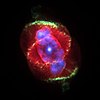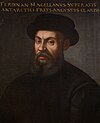User:Rfl/FeaturedArticle
Featured articles[edit]
Featured articles · candidates · collaboration of the week
May 31[edit]
The siege of Guînes took place from May to July 1352 when a French army under Geoffrey de Charny unsuccessfully attempted to recapture the French castle (pictured) at Guînes which had been seized by the English the previous January. The siege was part of the Hundred Years' War and took place during the uneasy and ill-kept truce of Calais. The strongly fortified castle had been taken by the English during a period of nominal truce and the English king, Edward III, decided to keep it. Charny led 4,500 men and retook the town but was unable to either recapture or blockade the castle. After two months of fierce fighting, a large English night attack on the French camp inflicted a heavy defeat and the French withdrew. Guînes was incorporated into the Pale of Calais. The threat posed by this enclave caused the French to garrison 60 fortified positions around it, at ruinous expense. The castle was besieged by the French in 1436 and 1514, but was relieved each time, before falling to the French in 1558. (Full article...)
April 31[edit]
Wikipedia:Today's featured article/April 31, 2005
March 31[edit]
A bicycle is a pedal-driven land vehicle with two wheels attached to a frame one in front of the other. First introduced in 19th century Europe, it evolved quickly into its current design. With over one billion in the world today, bicycles provide the principal means of transportation in many regions and a popular form of recreation in others. The bicycle has had considerable historical impact, in both the cultural and industrial realms. In its early years, bicycle construction drew on pre-existing technologies, while more recently bicycle technology has contributed in turn to other, newer areas. Beyond recreation and transportation, bicycles have been adapted for use in many occupations, in the military, and in sports and entertainment as well. A recurring theme in bicycling has been the tension between bicyclists and drivers of motor vehicles, each of whom argue for their fair share of the world's roadways.
Recently featured: George Fox – The Supremes – Venus
February 31[edit]
Wikipedia:Today's featured article/February 31, 2005
January 31[edit]
Super Mario 64 is a platform game, published by Nintendo and developed by its EAD division, for the Nintendo 64. Along with Pilotwings 64, it was one of the launch titles for the console.[5] It was released in Japan on June 23, 1996, and later in North America, Europe, and Australia. Super Mario 64 has sold over eleven million copies. An enhanced remake called Super Mario 64 DS was released for the Nintendo DS in 2004.
As one of the first three dimensional (3D) platform games, Super Mario 64 features free-roaming analog degrees of freedom, large open-ended areas, and true 3D polygons as opposed to two-dimensional (2D) sprites. It established a new archetype for the genre, much as Super Mario Bros. did for 2D sidescrolling platformers. Hailed as "revolutionary", the game left a lasting impression on 3D game design, particularly notable for its use of a dynamic camera system and the implementation of its analog control.
In going from two to three dimensions, Super Mario 64 placed an emphasis on exploration within vast worlds that require the player to complete multiple diverse missions, replacing the linear obstacle courses of traditional platform games. While doing so, it managed to preserve many gameplay elements and characters of earlier Mario games. The title is acclaimed by many critics and fans as one of the greatest and most revolutionary video games of all time. (more...)
Recently featured: Laal language – Pulaski Skyway – Aquarium
December 31[edit]
A planetary nebula is an astronomical object consisting of a roughly spherical glowing shell of gas formed by certain types of stars at the end of their lives. They are in fact unrelated to planets: the name originates from a supposed similarity in appearance to giant planets. They are a short-lived phenomenon, lasting a few thousand years of a typical stellar lifetime of several billion years. About 1,500 are known to exist in our galaxy. Planetary nebulae are important objects in astronomy because they play a crucial role in the chemical evolution of the galaxy, returning material to the interstellar medium which has been enriched in heavy elements by nucleosynthesis. In recent years, Hubble Space Telescope images have revealed many planetary nebulae to have extremely complex and varied morphologies. The mechanisms which produce such a wide variety of shapes and features are not yet well understood. (more...)
Recently featured: Max Weber – Turquoise – House of Lords
November 31[edit]
Wikipedia:Today's featured article/November 31, 2004
October 31[edit]
The "infinite monkey theorem" is a popular misnomer for an idea from Émile Borel's book on probability, published in 1909. The book introduced the concept of "dactylographic monkeys" seated in front of typewriter keyboards and hitting keys at random. Borel exemplified a proposition in the theory of probability called Kolmogorov's zero-one law by saying that the probability is one that such a monkey will eventually type every book in France's Bibliothèque nationale (national library). There need not be infinitely many monkeys; a single monkey who executes infinitely many keystrokes suffices. Subsequent restatements by other people have replaced the National Library not only with the British Museum but also with the Library of Congress; the most popular retelling says that the monkeys would eventually type out the collected works of William Shakespeare. (more...)
Recently featured: Louis XIV – Speed of light – Greco-Buddhism
September 31[edit]
Wikipedia:Today's featured article/September 31, 2004
September 6[edit]
The Warsaw Uprising was an armed struggle during the Second World War by the Polish Home Army (Armia Krajowa) to liberate Warsaw from German occupation and Nazi rule. It started on August 1, 1944 as a part of a nationwide uprising, Operation Tempest. The Polish troops resisted the German-led forces until October 2. An estimated 85% of the city was destroyed during the urban guerrilla war and after the end of hostilities. The Uprising started at a crucial point in the war as the Soviet army was approaching Warsaw. Although the Soviet army was within a few hundred metres of the city from September 16 onward, the link between the uprising and the advancing army was never made. This failure and the reasons behind it have been a matter of controversy ever since. (more...)
Recently featured: Anno Domini – PaX – Behistun Inscription
August 31[edit]
Ferdinand Magellan was a Portuguese sea explorer who sailed for Spain. He was the first to sail from Europe westwards to Asia, the first European to sail the Pacific Ocean, and the first to lead an expedition for the purpose of circumnavigating the globe. Though Magellan himself died in the East Indies before returning to Europe, some of the crew and fleet he organized and guided for half the journey did return there in 1522, having circumnavigated the globe. (more...)
Recently featured: Tank – Traditional counties of England – Russian language
July 31[edit]
A typewriter is a mechanical, electromechanical or electronic device with a set of "keys" that, when pressed, cause characters to be printed on paper. In the late 19th and the start of the 20th century the device operator was sometimes also called a "typewriter", though it then became more common to call the person a "typist". A typewriter has a keyboard, with keys for the characters in its font. The method by which the typewriter actually marks the paper now varies as greatly as types of printers do, but until the end of the 20th century it was by the impact of a metal (or, later, metallized plastic) element against an "inked" ribbon which caused ink to be deposited on the paper. (more...)
Recently featured: History of Scotland – Radar – Mitochondrial Eve
June 31[edit]
Wikipedia:Today's featured article/June 31, 2004
May 31[edit]
Helium is the chemical element in the periodic table that has the symbol He and atomic number 2. A colorless, odorless noble gas, helium has the lowest boiling point of any element and can only be solidified under great pressure. This element occurs as a monatomic gas. It is for practical purposes chemically inert. It is the second most abundant element in the universe after hydrogen. It is found in the Earth's atmosphere in trace amounts from the decay of certain minerals and is present in some mineral waters. Helium occurs in economically extractable amounts in certain natural gases and is used as a lifting gas for balloons and blimps, as a cryogenic cooling liquid for superconducting magnets. (more...)
Recently featured: Chinatown – Vowel – Ludwig Wittgenstein
April 31[edit]
Wikipedia:Today's featured article/April 31, 2004
March 31[edit]
Superman, also called The Man of Steel, is a fictional character, a superhero, starring in comic books bearing his name from DC Comics. The character has also been in various television series and movies. Superman was born as Kal-el on the planet Krypton. While still a baby he was put into a spaceship alone by his father. The ship launched moments before his home-planet exploded. His spaceship landed on Earth. (more...)
Recently featured: Jet engine – Yellowstone National Park – Bioinformatics








